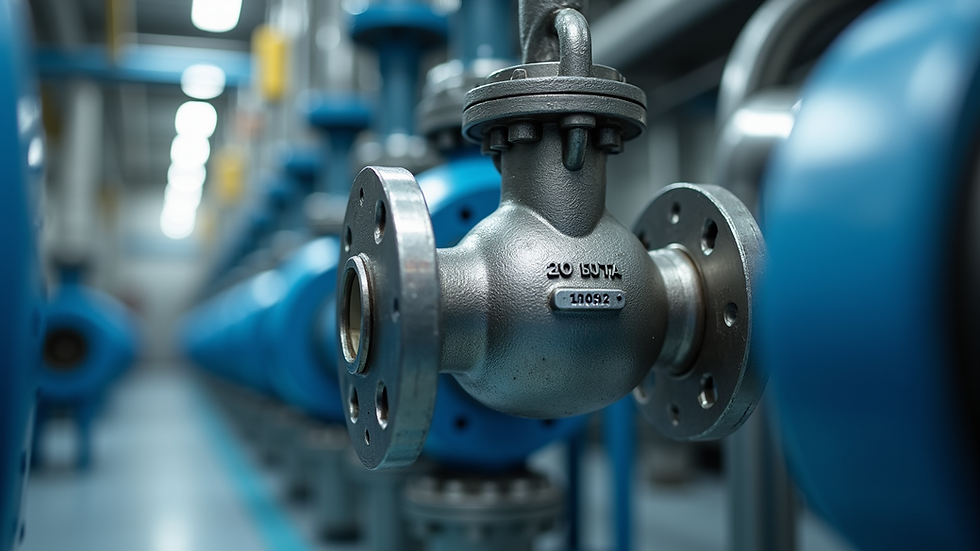Top Maintenance Tips for Your Valves
- Mark Richardson
- Aug 18
- 3 min read
Valves are essential components in many industrial and domestic systems. They control the flow of liquids, gases, and other materials, ensuring safety and efficiency. Proper maintenance of valves can extend their lifespan, prevent costly breakdowns, and improve system performance. This article provides practical valve maintenance tips to help you keep your valves in excellent condition.
Essential Valve Maintenance Tips to Follow
Regular maintenance is key to ensuring valves operate smoothly and reliably. Here are some important tips to keep in mind:
1. Inspect Valves Regularly
Perform visual inspections to check for leaks, corrosion, or damage. Look for signs of wear on seals and gaskets. Early detection of issues can prevent major failures.
2. Clean Valve Components
Dirt and debris can cause valves to stick or malfunction. Clean valve bodies, stems, and seats using appropriate solvents or cleaning agents. Avoid abrasive materials that could damage surfaces.
3. Lubricate Moving Parts
Apply suitable lubricants to valve stems and other moving parts to reduce friction and wear. Use lubricants recommended by the valve manufacturer to avoid compatibility issues.
4. Tighten Loose Bolts and Connections
Loose fittings can cause leaks and reduce valve efficiency. Check and tighten bolts, nuts, and flange connections as needed, but avoid over-tightening which can cause damage.
5. Test Valve Operation
Operate valves periodically to ensure they open and close smoothly. This helps prevent seizing and identifies any operational issues early.
6. Replace Worn or Damaged Parts
If seals, gaskets, or other components show signs of wear or damage, replace them promptly. Using genuine parts from trusted suppliers like valves4you.co.uk ensures compatibility and reliability.

Common Valve Problems and How to Avoid Them
Understanding common valve issues can help you prevent them through proper maintenance:
Corrosion
Corrosion weakens valve materials and causes leaks. Use corrosion-resistant valves for harsh environments and apply protective coatings when necessary.
Leakage
Leaks often result from worn seals or loose connections. Regularly inspect and replace seals, and ensure all fittings are secure.
Sticking or Seizing
Valves that do not move freely can disrupt system flow. Lubricate moving parts and operate valves regularly to keep them functional.
Wear and Tear
Continuous use causes wear on valve seats and discs. Schedule periodic maintenance and replace parts before failure occurs.
Improper Installation
Incorrect installation can lead to premature valve failure. Follow manufacturer guidelines and use professional services if needed.

How to Choose the Right Tools for Valve Maintenance
Using the correct tools makes valve maintenance safer and more effective. Here are some recommendations:
Wrenches and Spanners: Use adjustable or fixed wrenches sized appropriately for valve bolts and nuts.
Lubrication Equipment: Grease guns or oil applicators designed for valves ensure even and clean lubrication.
Cleaning Brushes and Solvents: Soft brushes and manufacturer-approved solvents help remove dirt without damaging valve surfaces.
Seal Replacement Kits: Keep kits handy for quick replacement of seals and gaskets.
Pressure Testing Devices: Use pressure gauges and leak detectors to verify valve integrity after maintenance.
Always wear appropriate personal protective equipment (PPE) such as gloves and safety glasses during maintenance.

Signs Your Valve Needs Professional Servicing
While many maintenance tasks can be done in-house, some situations require expert attention:
Persistent leaks despite seal replacement
Valves that fail to open or close fully
Excessive corrosion or damage to valve body
Unusual noises or vibrations during operation
Complex valve systems requiring calibration or testing
In such cases, contact a professional service provider or supplier like valves4you.co.uk for expert advice and repairs.
Best Practices for Valve Storage and Handling
Proper storage and handling prevent damage before installation or during downtime:
Store valves in a clean, dry place away from direct sunlight and corrosive environments.
Keep valves covered or sealed to prevent dust and moisture ingress.
Handle valves carefully to avoid dents, scratches, or bending of stems.
Use appropriate lifting equipment for heavy valves to prevent accidents.
Label valves clearly to avoid confusion during installation.
Following these practices ensures valves remain in optimal condition until they are needed.
Maintaining your valves with these practical tips will help you avoid costly repairs and downtime. Regular inspections, cleaning, lubrication, and timely replacement of parts are essential steps. Using the right tools and knowing when to seek professional help can further enhance valve performance and longevity. For quality valves and expert support, consider visiting valves4you.co.uk.



Comments